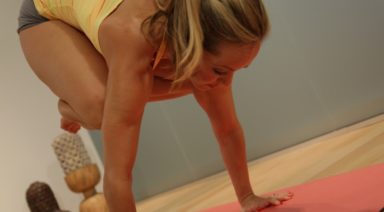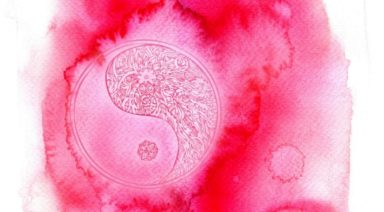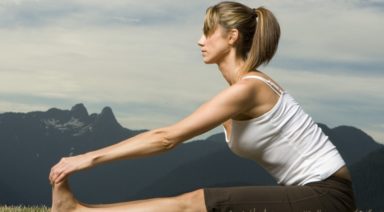Asana Anatomy-Chaturanga Dandasana

You’re finishing up your yoga class, you can almost feel savasana coming, then the teacher instructs you to perform one last vinyasa. As you step back to plank pose, and begin to lower down into Chaturanga or four legged staff pose, your shoulders dip forward from fatigue and your core refuses to co-operate as your belly sags to the floor. Chaturanga is an important, and even enjoyable, part of sun salutations and vinyasa flows. Keeping the integrity of the pose from the start to the end of our yoga practice is important to avoid injury and receive the many benefits chaturanga has to offer.
Let’s dissect this asana.
Preparation
Starting from plank pose, or high push up, our wrists are stacked under our shoulders and our body is parallel to the floor with our toes on the mat.
Upper Body
In plank pose, the pectoralis muscles of the chest are keeping us in a push-up position. To avoid sagging into the wrist joints, a common complaint in this pose, we need to recruit the larger muscles of our shoulders for support. Imagine your heart moving closer to the floor, and without bending the elbows allow the shoulder blades to glide closer to each other. This actively engages our rhomboid muscles between the shoulder blades and the spine, and the middle portion of our diamond shaped trapezius muscle.
Core
In plank pose, to avoid sagging into the low back or popping up with our hips, our core muscles must be engaged. Use a gentle contraction of uddiyana bandha, sucking the belly button up and in, flattening the lower belly. This action corresponds to engaging the transversus abdominus, which provides stability to the lower spine. A slight tuck under of the tailbone can aid this action. To distribute the work away from our core and upper body, press back through the heels, sending weight into the legs.
Lower Body
With our heels pressing back like we are pressing into a wall, we are activating the muscles that dorsi flex our ankles, namely tibialis anterior on the front of the shin. Our hamstrings lengthened by the action of the extended knee initiated by our quadriceps muscles in the front of the thighs. To keep our alignment, our thighs are pressing towards each other but not touching, like we are holding a block with the adductor muscles of the groin.
Anatomy in Motion
Starting from this place of stability and alignment, we can now safely flow into the pose.
Upper Body
The most complex movements in Chaturanga come from our upper body. In order for us to lower, a number of actions must occur. Firstly, we must balance the action of inward and outward rotation at the shoulder joint. The outward rotation of teres major and infraspinatus muscles of the rotator cuff counteract the inward pull of the pectoralis muscles, and latisimus dorsi on the back. By nature of the fact that our palms are on the mat, the pronator muscles of the forearm are activating an inward rotation at the wrist. To maintain neutral rotation at our shoulder joint, our elbows must hug to our sides to engage the triceps, whose natural action is pure flexion and extension at the elbows. It is important that we keep the engagement of the scapular support muscles that we started with in plank pose. This means that we keep an open heart moving forward, broad across the collarbones, and our shoulder tips never drop below our elbows. The subscapularis muscle of the rotator cuff (on the underside of the shoulder blade) is working over time to prevent the arm bone from moving forward out of the shoulder joint.
Core
We maintain the contraction of the transversus abdominus throughout Chaturanga, which keeps our body parallel to the floor and avoids any lower back discomfort. Imagine your side body growing long as your heart shines forward and your heels press firmly back.
Lower Body
The action of pressing back through the heels maintains length through the legs and deep hip flexor muscle, the psoas, which has attachments in the spine and the legs. The legs support our upper body so that Chaturanga becomes a full body pose, not just an arm balance.
Benefits & Considerations
Chaturanga is an excellent pose to build awareness of the muscles that support and stabilize our shoulder blades. It is important to be mindful as we enter the pose, setting up the action of the shoulder blades pressing together. If we do allow the shoulders to tip forward, this can result in injury to our sensitive rotator cuff muscles.
Chaturanga is also an excellent core exercise. If you find that as your practice goes on it is difficult to maintain your body parallel to the floor, it is better to drop to your knees but stay aligned from your knees to the crown of your head. If you are finding wrist discomfort, ensure that you are distributing weight throughout the palm, not just on the inner portion which may be overcome by the pronation (inward rotation) in your forearms. Wrist pain can also be a sign that you have not accessed the power in your shoulder muscles. Of course sometimes aches and pains may signal a larger injury so it is important to consult with a health professional that understands yoga.
Now Flow
Chaturanga Dandasana gives us a feeling of power, accessing our inner strength as well as building our outer strength. It enables us to flow gracefully through our sun salutations and between poses, and when done with mindful alignment can be a satisfying and fulfilling asana.
Pigeon | Yoga Pose

ADJUSTMENTS | BENEFITS | CONTRAINDICATIONS | MANTRA | MUDRA | PREP POSES | SANSKRIT | STEPS | TIPS
Eka pada rajakapotasana (aa-KAH pah-DAH rah-JAH-cop-poh-TAHS-anna), also known as pigeon or one-legged king pigeon pose, is an intermediate backbend that relieves nerve tension and chronic pain while increasing circulation and helping us control our desires. During this exercise, make sure to maintain a focus on your breathing. We often forget to consciously focus on our breathing, taking full breaths throughout the entire exercise. Pay attention to how pigeon pose affects your breathing.





































